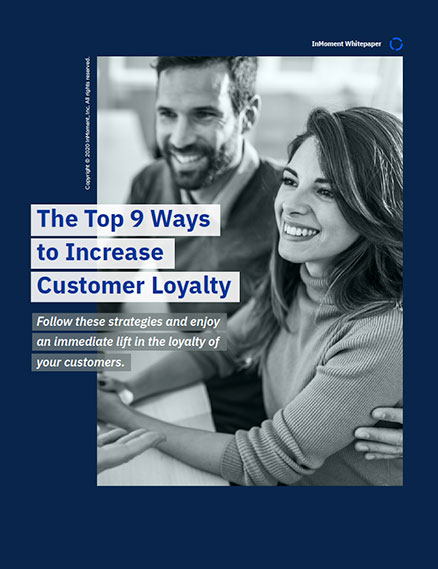Customer Loyalty Means Sticking Around When It Isn’t Easy, Rejecting Competition, and Believing in a Transcendental Customer-Company Relationship
Customer loyalty is believing that an organization’s product is the best option. It’s more than a casual friendship. Customer loyalty means sticking around when it isn’t easy, rejecting competition and believing that the customer-company relationship transcends products and services.
Most people aren’t 100% loyal to one brand. One may shop from three grocery stores, loyal to them all, and none others, but not loyal to one completely. This has been termed polygamous customer loyalty. Due to split loyalties, it is in the best interest of companies to invest in customer loyalty and be the one that holds the most wallet share. Loyal customers can keep sales coming, even in economic downturns, they can purchase supplementary products/services, bring in new customers and reduce costs for consumer marketing.
What are the Different Levels of Customer Loyalty?
There are four different levels of customer loyalty:
- Active loyalty: – This level of customer loyalty encompasses your most valuable customers. These customers buy the essential and non-essential products you sell. They are active in their promotion of your brand.
- Habitual loyalty: – This level of customer loyalty contains the customers that are loyal by habit, but not actively promoting your brand. These customers are repeat customers for all their normal purchases but will shop around for alternative products on occasion.
- Situational loyalty: – This level of customer loyalty is where customers shop around for most of their purchases but for specific occasions or products buy loyally.
- Active disloyalty: – This level of customer loyalty seats those who have no customer loyalty whatsoever. This type of customer needs reasons to stay loyal to a company, such as special discounts, loyalty programs, and exclusive offers.
Customer loyalty can also come in two different types, behavioral and attitudinal. Behavioral loyalty refers to those who buy the company’s products and tell their friends about them. Whereas attitudinal loyalty refers to the positive emotions that people have towards a company or its products. As social media and the internet have emerged to increase competition and challenge customer loyalty, it has become increasingly important to look for ways to appease customers from all walks of the customer loyalty life.
Customer loyalty can be confused with similar terms such as brand advocacy, loyalty programs, and customer satisfaction. Brand advocates believe in what the company stands for, regardless of products/services. Not all brand advocates are loyal customers. The inverse is also true. Not all loyal customers are brand advocates. Loyalty programs don’t often affect customer loyalty. Usually, they are executed improperly and result in the equivalent of discounted rates rather than loyal customers that stay. Customer satisfaction is also a small indicator of customer loyalty. While it plays a part in it, customer loyalty is more than just a good experience.
What Is Employee Loyalty?
In order to build good customer loyalty, employee loyalty needs to come first. Making sure employees are engaged and happy at work is vital. As the saying goes, “The fish stinks from the head down.” Employees are the ones that pass loyalty down to the customers. It’s important that employees are invested in the values of the company and are trained in order to produce the most loyal customers. Evaluating the connection employees have with the company can be done by using a Voice of the Employee (VoE) program.
Why is Customer Loyalty Important?
Studies show that it costs five times more to find new customers than to keep your existing ones. That means that although you can’t control all the customer churn, it is really important that you have a strategy to making and keeping loyal customers.
Repeat customers have also been shown to spend as much as 31% more on products than new customers, and are 50% more likely to try a new product. That’s a lot of revenue to miss out on if you don’t focus on building customer loyalty.
With the rise of social media and video reviews, the ordinary opinion has come to matter more than ever. 92% of customers rely on reviews and video testimonials to help them determine which products to buy. By creating more customer loyalty, it is easier to reach new customers as loyal customers post and share content that promotes your products. In contrast, without customer loyalty, negative testimonials and content shared on social media can drastically damage future customer loyalty prospects.
How Do You Create Customer Loyalty?
Research shows that 73% of a customer’s love for a brand comes from great service and more than 70% of buying experience comes from how the customer feels they are being treated. It’s no secret that obtaining the loyalty of customers is a strategic imperative. While there are a myriad of tips and tricks to acquiring and holding on to customers, what it essentially boils down to is trust. Customer loyalty can be analogous to a marriage. Like any good marriage, it requires lots of trust, work, and communication. Below are a few guidelines to employ when interacting with customers.
- Analyze what is and isn’t working. Improve what isn’t
- Exceed customers’ expectations
- Establish a personal relationship with every customer
- Follow the rules: Golden Rule (do unto others as you would want to be done unto.) and the Platinum rule (interact with others as they want to be interacted with.)
- Share your values
- Be Transparent
- Admit when you make a mistake. Take responsibility and resolve issues
- Ask for their feedback
- Take action on feedback
- Earn a reputation for being consistent and reliable
- Be flexible
- Surprise them
There is no shortcut to earning customers that trust a company. Customer loyalty is built on trust and there are three must-haves for building customer trust and loyalty. A company has to be worthy of that trust—by building positive, genuine relationships and experiences with customers.

WHITE PAPER
The Top 9 Ways to Increase Customer Loyalty
Fostering true loyalty and engagement with customers starts at a basic level. These nine principles will guide you in your efforts to create greater customer loyalty and engagement within your organisation. Creating customer loyalty is one of the most critical ways to retain more of your customers and grow your business faster. It can also be a powerful competitive edge.
How Do You Measure Customer Loyalty?
There are many ways to measure customer loyalty. From using the Net Promoter Score (NPS) and Customer Effort Score (CES) to analyzing customer retention and negative churn. Here are a few other ways that customer loyalty can be discerned:
- Repurchase Ratio-How many repeat buyers vs. one-time buyers?
- Upselling Ratio-How many people who’ve bought multiple products vs those who’ve only bought one.
- Customer Loyalty Index
- Activity Time-How much time does your customer spend with your product?
- Visit Frequency-How often does your customer return to your product?
Conclusion
Customer loyalty is perhaps the greatest predictor of a company’s success. In order to build that, the employees must be loyal first. In turn, they’ll pass that on to the customers. If customers are loyal, it means they trust the company and will continue to purchase products and services. By genuinely caring about the customer, seeking feedback, and continuously measuring indicators of customer loyalty, companies can acquire and keep customers coming back for a lifetime.

See ROI in Half the Time
InMoment’s integrated CX approach increases customer lifetime value and bottom line performance in just 12 months, significantly faster than the industry average of 25 months!
Estimated ROI (payback period in months)



